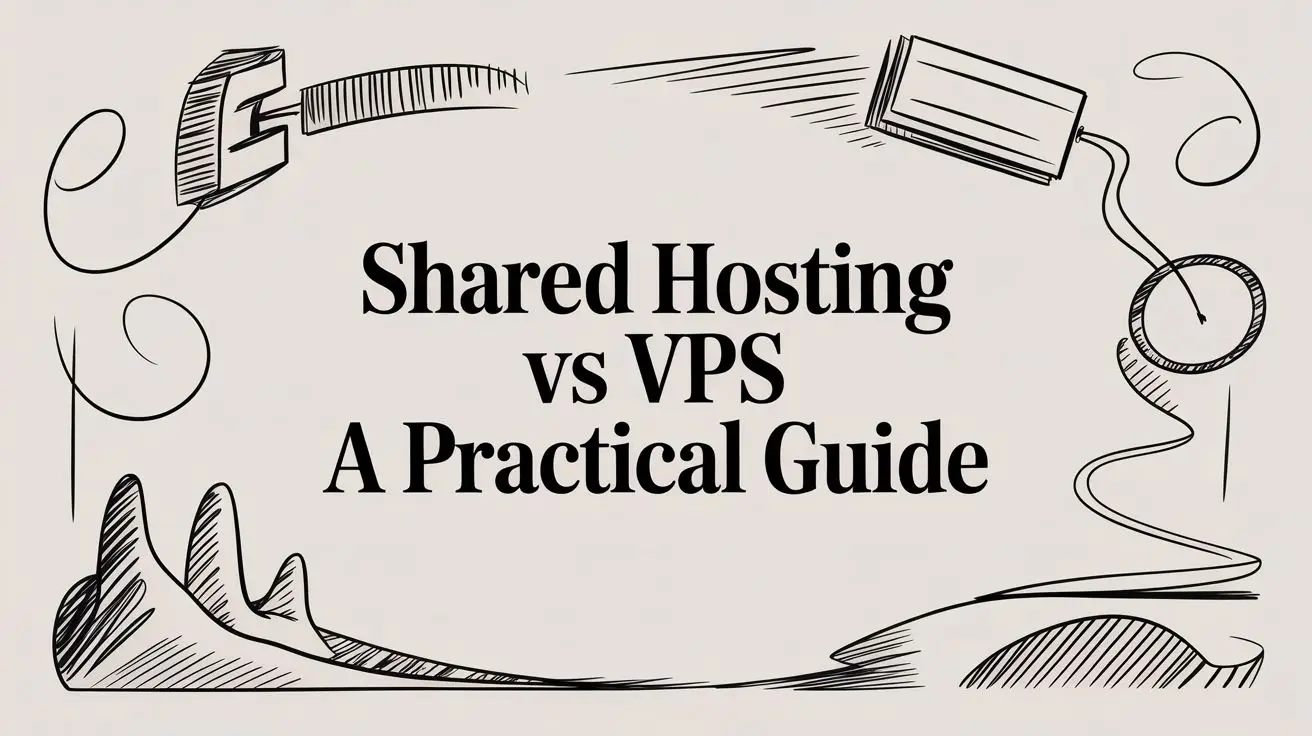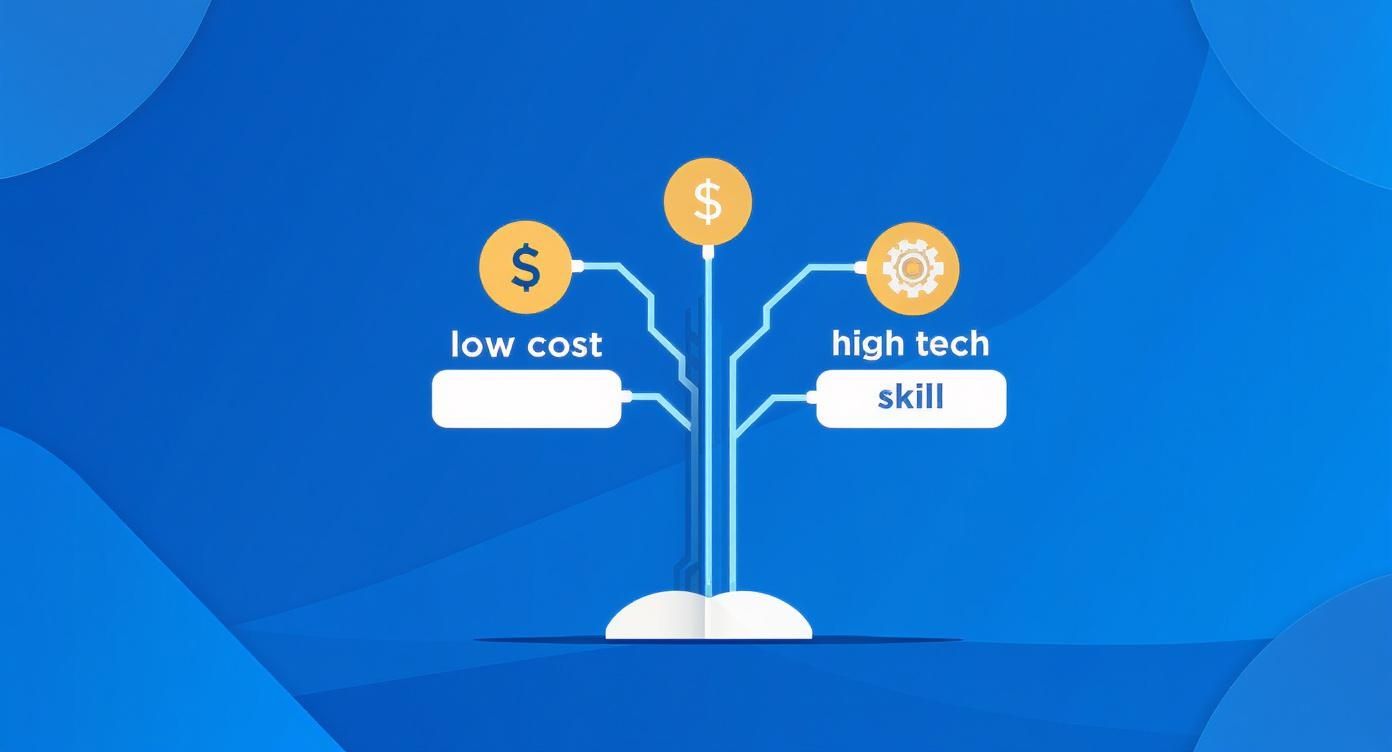
When you're comparing shared hosting vs. a VPS, the real difference boils down to two things: resources and control.
Think of it this way: shared hosting is like an apartment building. You get a great price and all the essential utilities are handled for you, but you're sharing the building's resources with all the other tenants. If your neighbor decides to throw a massive, noisy party, you might feel the effects. A VPS (Virtual Private Server), on the other hand, is like owning a townhouse. You have your own dedicated space, guaranteed utilities, and the freedom to renovate however you like. It's a clear step up for anyone who's outgrowing their first apartment.
Choosing Your First Web Hosting Solution
Picking between shared hosting and a Virtual Private Server (VPS) really depends on where you are right now and where you plan to go. If you're just getting started—launching a personal blog, a portfolio site, or a small business landing page—shared hosting is an incredibly straightforward and budget-friendly way to get online.
There's a reason it's so popular. Shared hosting is still the biggest slice of the pie, pulling in around 37.5% of the total global market revenue in 2024. Its low cost makes it the default choice for the vast majority of small to medium-sized businesses, which, let's not forget, make up over 90% of all businesses worldwide. You can find more details in these recent web hosting statistics on hostadvice.com.
But what happens when your site starts to take off? That's where a Virtual Server comes in. It gives you a guaranteed slice of server resources and full root access, making it the logical next step for an e-commerce store with growing sales, a developer who needs a specific software stack, or any website seeing a steady climb in traffic.
Making the right choice from the start can save you from future performance headaches and painful migrations. If you need more guidance, our article on the 5 key factors to consider when choosing a hosting provider can help you weigh your options.
Quick Comparison: Shared Hosting vs VPS
To make things even clearer, here’s a quick side-by-side look at the key differences between shared hosting and a VPS. This table cuts straight to the chase, helping you see which one aligns with your project's needs.
| Attribute | Shared Hosting | VPS (Virtual Private Server) |
|---|---|---|
| Cost | Lowest monthly cost, ideal for budgets | Higher initial cost, better value for growth |
| Performance | Resources are shared and can fluctuate | Guaranteed, dedicated resources ensure consistency |
| Control | Limited; managed by the provider | Full root access for complete customization |
| Security | Shared environment, potential for "bad neighbor" issues | Isolated environment for superior security |
| Technical Skill | Beginner-friendly, no server management needed | Requires technical knowledge (or a managed service) |
| Best For | New blogs, personal sites, low-traffic businesses | Growing businesses, e-commerce, developers |
Ultimately, the choice comes down to your immediate needs versus your long-term ambitions. Shared hosting gets you in the game quickly and affordably, while a VPS gives you the power and flexibility to scale without limits.
Decoding Performance and Resource Allocation

To really get a grip on your website's speed and reliability, you have to start with how server resources are handled. With shared hosting, things like CPU, RAM, and bandwidth are all thrown into one big pool for everyone on the server. This setup can work just fine for small sites with light, predictable traffic.
But that communal approach has a major downside, something we call the "noisy neighbor" effect. Picture this: another website on your server suddenly goes viral. That site starts hogging the shared resources, and suddenly, your perfectly fine website slows to a crawl or even goes down. It's completely out of your control.
A great way to spot this problem is by looking at your Time to First Byte (TTFB). This metric tells you how quickly the server responds to a request. If your TTFB is high, it’s a classic sign of an overloaded shared server—you're feeling the noisy neighbor effect firsthand.
You can check your site’s TTFB and other critical metrics with free tools like GTmetrix. It's a quick, concrete way to see if server issues are tanking your user experience.
The Predictability of VPS Hosting
This is where the real difference between shared hosting and VPS hosting comes into sharp focus. A Virtual Private Server (VPS) uses virtualization technology, like KVM (Kernel-based Virtual Machine), to slice a physical Bare Metal server into multiple, totally isolated virtual machines.
That isolation is key. It means the resources you pay for—whether it's 2 vCPU cores or 4 GB of RAM—are 100% guaranteed and dedicated to you. What another user does on the same physical machine has absolutely no impact on your site's performance.
With a stable VPS environment, you can start digging into more advanced strategies for application performance optimization. A VPS gives you the solid foundation you need to make those tweaks count.
A Technical Look at VPS Resource Management
On a VPS, you get direct, granular control over your environment, something that's simply not possible with shared hosting. For instance, once you SSH into your server, you can see exactly what's happening with your resources in real-time.
A simple command gives you all the insight you need:
Check real-time CPU and memory usage
top
Running this command shows you precisely how much CPU and RAM your applications are using. This allows for meticulous performance tuning and is a core advantage of making the switch. For a deeper dive into these technical benefits, check out our guide to VPS hosting.
Ultimately, a VPS takes the guesswork out of performance. You’re no longer rolling the dice. Instead, you get a stable, predictable, and scalable Cloud-based foundation that ensures your website has the power to grow without being held back by others.
Comparing Security Models and Server Isolation
When you're weighing shared hosting vs. a VPS, security isn't just a simple checkbox feature—it's a fundamental difference in architecture. Shared hosting platforms rely on broad, server-wide security tools managed by the provider, like firewalls and malware scanners. These are generally good at catching common, known threats.
The catch? The very nature of shared hosting creates an inherent risk. Because you're sharing a server with dozens or even hundreds of other websites, a security slip-up on one site can potentially open the door for attackers to poke around at others. It's like living in an apartment building where a master key can open every door; if that key gets into the wrong hands, everyone's at risk.
A Virtual Private Server (VPS), on the other hand, delivers vastly better security through true isolation. Thanks to virtualization technology, each VPS is walled off into its own self-contained environment, acting for all intents and purposes like a completely separate server.
This isolation is the key differentiator. One user’s mistake or security breach can't directly spill over and affect your server. Your files, database, and network traffic are kept entirely separate, creating a strong digital barrier between you and your neighbors on the same physical hardware.
Of course, with a VPS, you shoulder more of the security workload yourself, but this control is exactly what allows you to build a much tougher defense. Regardless of your hosting choice, it's always smart to implement essential website security best practices to keep your site locked down.
Hardening a New VPS: A Practical Example
Getting root access on a VPS is a game-changer. It lets you configure custom security rules that are perfectly tuned to your application’s specific needs—something that’s simply not possible on a shared plan. For instance, you can lock down your firewall to only allow traffic that is absolutely essential for your site to function.
Here’s a quick look at how you’d set up a basic firewall on a new Ubuntu server using ufw, which stands for Uncomplicated Firewall. This is a crucial first step in any new Virtual Server deployment.
Check UFW Status: First, you’ll want to see if it’s installed and what its current status is.
sudo ufw statusSet Default Rules: The best starting point is to deny all incoming connections by default while allowing all outgoing ones.
sudo ufw default deny incomingsudo ufw default allow outgoingAllow Essential Ports: Next, you open up only the ports you absolutely need, like SSH (port 22), HTTP (port 80), and HTTPS (port 443).
sudo ufw allow sshsudo ufw allow httpsudo ufw allow httpsEnable the Firewall: Finally, you just turn it on.
sudo ufw enable
Just by running these few commands, you've dramatically improved your server's security by closing off countless potential entry points for attackers. This is just a small taste of the hands-on control a VPS gives you—control that ultimately leads to a far more secure environment.
Control, Customization, and Scalability: The Real Dealbreakers

This is where the rubber really meets the road in the shared hosting vs. VPS debate. The amount of control you get over your server environment is arguably the single biggest difference between the two.
Shared hosting is built for simplicity. You get a user-friendly control panel like cPanel or Plesk that handles all the gnarly server administration for you. For beginners, it's perfect—everything just works.
But that simplicity comes with a trade-off: customization. You're living in someone else's house, playing by their rules. You can't install a different operating system, a niche PHP module, or a specific version of a programming language if the provider doesn't support it for everyone on the server.
A Virtual Private Server (VPS), on the other hand, throws you the keys to the kingdom. You get full root access, the highest level of administrative power possible. This means you can install whatever software you want, choose your favorite Linux distribution (like AlmaLinux or Debian), and tweak server settings until they're perfectly dialed in for your needs.
What Does VPS Control Look Like in Practice?
Let's imagine you're a developer building a modern web app with Node.js. On most shared hosting plans, you're dead in the water—it's just not an option.
With a VPS, you can simply SSH into your server and install it yourself. It’s that direct.
A typical setup process on a new Virtual Server might involve:
- Updating Your Server: First, make sure all system packages are current with
sudo apt update && sudo apt upgrade. - Installing Node.js: Use a version manager like
nvmto grab the exact version your project requires:nvm install 18.17.1. - Deploying a Process Manager: Install a tool like PM2 (
npm install pm2 -g) to ensure your application runs 24/7 without manual intervention.
This kind of granular control is precisely why developers and growing businesses eventually move on from shared hosting. It’s this blend of power and affordability that has solidified the role of VPS hosting as the essential next step. In fact, the VPS market is projected to capture up to 25.38% of the global web hosting market by 2025 as demand for this balance grows. You can dive deeper into these current market trends on digitalsilk.com.
Growing Pains vs. On-Demand Scalability
Scalability is another night-and-day difference. On a shared plan, "scaling" usually involves a clunky migration to a higher-tier package. This isn't just about paying more; it often means dealing with potential downtime and the headache of moving your site.
With a VPS, scaling is fluid and on-demand. Most Cloud and Virtual Server providers let you add more CPU, RAM, or storage with just a few clicks and a quick reboot. This dynamic capability means your infrastructure can grow in lockstep with your traffic, not in awkward, disruptive leaps.
A Realistic Look at Cost vs. Technical Effort
Shared hosting is the undisputed low-cost leader, and for good reason. The price is low because server management is completely handled for you, and the costs are spread across many users. It’s an incredibly efficient entry point for new projects where budget is the primary concern.
But a true cost analysis has to factor in the value of your time. This is where the VPS conversation gets interesting, especially when considering Managed Services.
VPS pricing is tiered, and it reflects a fundamental split in responsibility. An unmanaged VPS looks incredibly cheap on paper, but that low monthly fee comes with a catch: you’ve just become your own system administrator. That means everything—from the initial server setup to ongoing maintenance—is now on your to-do list.
The Hidden Costs of an Unmanaged VPS
The technical workload for an unmanaged virtual server is no small thing. Suddenly, you're responsible for:
- Security Patching: Constantly applying updates to the operating system and software to protect against the latest vulnerabilities. Miss one, and you could be in big trouble.
- Software Installation: Manually installing and configuring your web server (like Apache or Nginx), database, and every other application your site needs to run.
- Troubleshooting: When something breaks—and it will—you’re the one diagnosing the problem. That could be anything from a performance bottleneck to a service that just won’t start.
This hands-on management is the real "cost" you need to weigh when comparing shared hosting to a VPS. It's not just about the monthly bill.
As one cloud engineer aptly put it: "The cost of an unmanaged VPS is the monthly fee plus the hours you spend maintaining it. If those hours are better spent on your business, a managed solution is the smarter investment."
A Managed VPS is a type of Managed Service that costs more upfront, but it completely removes that management overhead. You get expert support to handle the technical heavy lifting, which bridges the gap for anyone who needs more power without wanting a second job as a sysadmin. It allows you to focus on your business, not on server maintenance.
When you're evaluating different types of website hosting, this balance between dollars spent and time invested is one of the most critical parts of the decision.
Making the Right Choice for Your Use Case
Let's move past the theory and get practical. The real difference between shared hosting and a VPS snaps into focus when you look at actual, real-world projects. Each option is built for a specific job, so picking the right one means you’re not just buying hosting—you're investing in a platform that can handle what you have now and what you plan to build next.
For anyone launching a personal blog, a simple portfolio site, or a basic brochure website for a small business, shared hosting is a no-brainer. These sites generally have predictable, low traffic and don't need any special server tweaks. It's the most efficient and budget-friendly way to get online.
When to Upgrade to a Managed VPS
A Managed Virtual Server is the logical next step when your website starts pushing the limits of a shared environment. This isn't just a gut feeling; the move is usually triggered by real growth that demands more power and stability.
You should seriously consider upgrading when:
- Your E-commerce Store is Taking Off: A growing product line and more daily sales mean you need the dedicated resources of a VPS. This ensures your pages load quickly and customers fly through checkout without a hitch. A managed service takes care of the server so you can focus on sales.
- Your Blog Traffic is Climbing: If your content is consistently pulling in more visitors, a VPS will keep your site from slowing down during traffic spikes, giving everyone a better experience.
- You Just Need Rock-Solid Reliability: For any site that's critical to your business, the isolated environment of a VPS is a huge win. You get far better stability and avoid the "noisy neighbor" problem common with shared hosting.
This decision tree infographic does a great job visualizing the choice based on your budget and technical confidence.

As you can see, once your technical needs and budget grow, making the jump from a shared plan to a VPS is the most practical path forward.
The Developer’s Choice: An Unmanaged VPS
For developers, sysadmins, and anyone comfortable in the command line, an unmanaged Virtual Server offers total freedom. If you're building custom apps, need a specific software stack (like a particular version of Node.js or Python), or require a dedicated staging environment to test things, the root access you get with a VPS is non-negotiable.
This level of control makes a VPS the perfect middle ground before a project gets so big it needs the raw horsepower of a Bare Metal dedicated server. Speaking of which, dedicated hosting occupies a smaller but more premium slice of the market. In 2024, it accounted for about 27.9% of all web hosting services. While the price tag is much higher, the investment makes sense for high-traffic enterprises that need completely dedicated hardware and advanced security. You can find more web hosting market shares at diviflash.com.
Still Have Questions? Let's Clear Things Up.
Choosing between shared hosting and a VPS can feel like a big step, so it's natural to have a few last-minute questions. Here are some straightforward answers to the most common things people ask.
Can I Upgrade From Shared Hosting to a VPS Later?
Absolutely. In fact, it’s one of the most common upgrades we see. Think of it as a natural growth path for your website—you start with shared hosting and move up to a VPS when your traffic and resource needs demand it.
Virtually every hosting provider has a well-defined process for this. They typically offer:
- Simple Migration Tools: Easy-to-use dashboards that help you move your files, databases, and key settings over.
- Expert Migration Help: For Managed VPS plans, many hosts will have a team that handles the entire move for you, making sure there's little to no downtime. This is a key benefit of choosing a provider that offers strong Managed Services.
This isn't a risky or unusual move; it’s an expected part of building a successful online business. You can confidently start small on shared hosting, knowing there's a clear path to more power when the time is right.
Is an Unmanaged VPS Too Difficult for a Beginner?
For someone with zero server administration experience, jumping into an unmanaged VPS is a steep learning curve. The total freedom it gives you also means you're totally responsible for security patches, software updates, and fixing things when they break.
An unmanaged VPS essentially makes you your own system administrator. If terms like 'SSH,' 'configuring a firewall,' or 'package manager' sound foreign, you could easily leave your server vulnerable or misconfigured.
If you need the dedicated power of a VPS but don't have the technical chops, a Managed VPS is the perfect middle ground. You get the same isolated, high-performance environment, but a team of experts takes care of all the complex server management behind the scenes.
Does a VPS Guarantee My Website Will Be Faster?
A VPS guarantees you get dedicated resources, which is the single most important ingredient for speed. It solves the "noisy neighbor" problem from shared hosting, where another site can hog the server's CPU and RAM. With a VPS, your slice of the server is yours and yours alone, giving you a stable performance baseline.
But just having a VPS doesn't automatically make your site fast. Think of it like a powerful engine—it has the potential, but you still need to tune the car. Overall speed is heavily impacted by things you control, like:
- Clean Code: Ensuring your website's code is efficient and not bloated.
- Image Optimization: Using properly sized and compressed images to slash load times.
- Efficient Databases: Making sure your database queries are optimized to retrieve information quickly.
Bottom line: A VPS gives you the raw power and stability needed for a fast website, but you still need to apply good development practices to make the most of it.
Ready to scale with confidence? ARPHost, LLC offers a full range of high-performance hosting solutions, from beginner-friendly shared hosting to powerful KVM Virtual Private Servers and Bare Metal dedicated servers. Explore our managed and unmanaged plans to find the perfect fit for your project at https://arphost.com.


1 comment on “Shared Hosting vs VPS A Practical Guide”